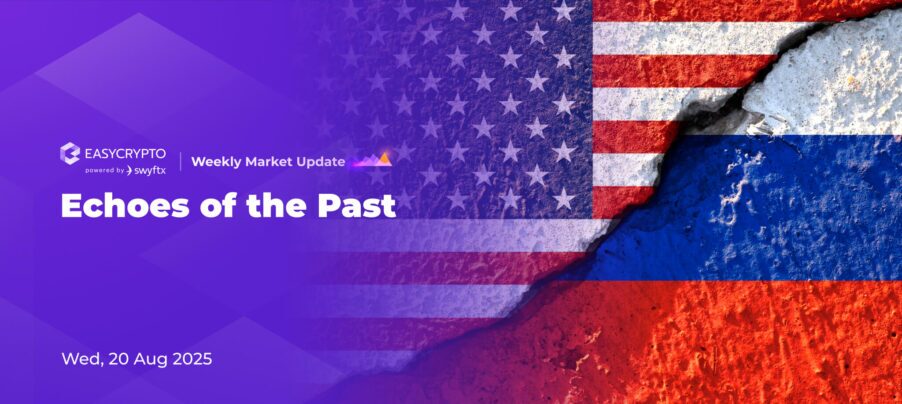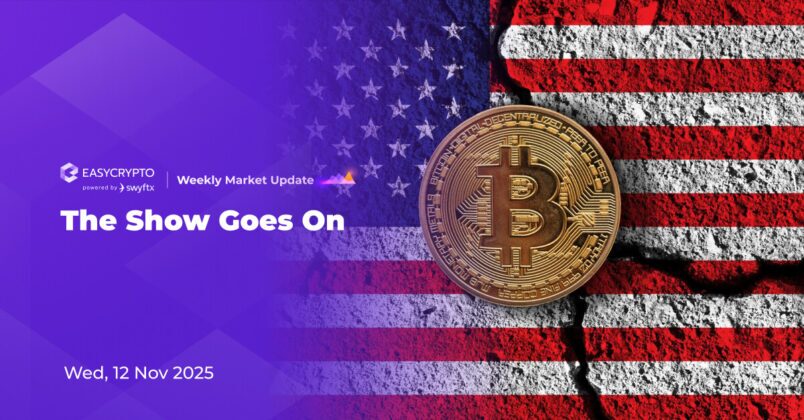Weekly Market Update: Echoes of the Past
Bitcoin has broken new all-time highs above $124k amidst global tensions. We take a look at how ongoing geopolitical shifts, including a changing world order and monetary easing, have created an environment where Bitcoin can thrive as a leading indicator and a beneficiary of these macro trends.


Bitcoin new all-time highs! What’s next?
Last Friday’s meeting of Presidents Trump and Putin in the frontier landscape of Alaska for de-escalation talks carries an unsettling echo of the Cold War era, as the unipolar world order, long dominated by the United States, faces growing challenges from an emerging multipolar future.
“Those who cannot remember the past are condemned to repeat it,” cautioned George Santayana, famous philosopher, poet and cultural critic.
A truth that Russia has lived for centuries, standing firm against Western pressures. From Peter the Great’s triumphs over Sweden to Napoleon’s frozen retreat in 1812 and Hitler’s shattered ambitions in the 1940s, Russia has honed its resilience.
Far from a Soviet relic, it’s now a modern industrial superpower, weaving fierce nationalism with Christian orthodoxy, its posture is resolute and unwavering. But NATO’s continued expansion since the end of the Cold War – adding Poland in 1999, the Baltics in 2004 and eyeing Ukraine – pushed Russia over the edge.
History shows subduing Russia is no easy task; whether Western leadership can succeed remains doubtful! Sanctions aimed at breaking Russia’s economy have so far faltered as energy exports and heavy defense spending continue to fuel its growth.
Yet, high inflation, a weakened Ruble and labor shortages from war and emigration strain its momentum. Both sides need an end to the Russia-Ukraine war!
Western sanctions are a double-edged sword, delivering economic pressure but risking more self-inflicted harm. The G7 already grapples with its own internal woes: four members – Japan, Italy, the U.S., and France – rank among the world’s ten most indebted nations, with Canada and the UK not far behind. Their economies continue to stagnate amid political gridlock over pet projects and social initiatives, while critical infrastructure crumbles from neglect.
The U.S. is relying on further monetary easing through Federal Reserve rate cuts starting in September to boost liquidity, but with government debt, major stock indices, housing, gold, and Bitcoin already at record highs, additional cuts further risk fueling inflation.
Bitcoin, a leading indicator and beneficiary of loose monetary policy, thrives in such conditions.
The Bitcoin halving is cleverly timed with the U.S. economic cycle. When examining the past Bitcoin cycles, you can see that the price has tended to surge in the second half (H2) of post-halving years:
- 2012 (H2): +101.49% (from $6.70 to $13.50)
- 2016 (H2): +43.32% (from $674 to $966)
- 2020 (H2): +217.21% (from $9,140 to $28,993)
We are in the beginning of that period right now, following the last April 2024 Bitcoin halving.
After breaking new all-time highs last week, Bitcoin has pulled back on broad market jitters into a continued consolidation phase and potentially preparing for another breakout. *Just observation and not financial advice!
Adding to bullish confidence is the fact that none of the major bull market peak indicators witnessed in the previous cycles parabolic blow-off-top phase (e.g., extreme retail euphoria or RSI overbought signals) have flashed a warning yet.
History suggests that neither the (Russian) bear nor the (Bitcoin) bull is exhausted just yet.
Market sentiment has held strongly in: Fear.
Crypto market moves:
- Wild swings driven by macro and geopolitical news flows that saw Bitcoin break new all-time highs above $124k mid-last week before enduring multiple pullbacks down to below $113k on broader tech sector risk-off sentiment and profit talking.
- Despite Bitcoin highs, ETF inflows remained relatively muted at just $550m last week – but expect some heavy selling pressure with today’s pullback.
- Ethereum ETFs stole the show, first with a record >$1 billion of inflows last Tuesday and then a weekly total of $2.8 billion.
- The total crypto market cap remained above $4 trillion until today’s broad market sell off.
- Retail seems to be waking up and joining the party again as Google search volume for the term “Crypto” hit a multi-year high last week, and “Bitcoin” is also trending back up.
- Crypto leverage expanded across all sectors in Q2 2025, with DeFi lending reaching an all-time high, CeFi lending growing and futures open interest surging to +37.47% QoQ.
- Bitcoin monthly RSI momentum indicator has held strongly above the ‘bullish’ 70 level.
- BTC dominance has dropped below 60% as ETH:BTC ratio continues to improve!
- The Fear and Greed index has dropped back into “Fear” territory with today’s sell off.
- The big winner of the week is XMR (Monero) +2.7%, as it recovers from the 51% attack last week (more info in following section)
- The surprise mover of the week is LINK (Chainlink) +1.8%, remaining in the green as it stole some of XRP’s shine with the ICE Partnership news.
- The big losers of the week are ENA (Ethena) -18.9% and PENGU (Pudgy Penguins) -19.2%, retracing some of the big gains from the previous week’s rally.
View all top gainers: Visit the top gainers page to find out more.
Highlights from the crypto space
Bitcoin has been above $100k for over 100 consecutive days, peaking at a new all-time high above $124k last Wednesday.
This has been fueled by growing expectations of monetary policy easing by the U.S. Fed. Ethereum continued to outperform, propelled by robust ETF inflows and expanding corporate treasury allocations.
The rally was halted abruptly last Friday as Bitcoin led a sharp pullback below $115k triggered by unexpectedly high U.S. Producer Price Index (PPI) data.
Treasury Secretary Bessent intensified the sell-off by confirming the U.S. government will not purchase Bitcoin but will rather use confiscated assets to build a Bitcoin reserve.
BitMine made the largest Ethereum purchase ever as its holdings are now valued at nearly $5 billion, owning 1% of the asset’s circulating supply. Wow!
Google search volume for the term “crypto” has reached a 12 month high:
Millions of Americans saving for retirement through 401(k) accounts could soon have the option of putting their money in higher-risk private equity and crypto investments, according to an executive order signed by President Trump. Federal agencies would need to rewrite rules and regulations, which could take a few months to complete, to enable this. Keep an eye on this!
It’s finally over, The SEC concluded its near 5 year case against Ripple Labs for selling unregistered securities, upholding a $125 million fine and resolving one of the industry’s most highest profile lawsuits. The XRP price rallied briefly on the news before pulling back into its consolidation range above $3.
After failing to acquire Circle pre-IPO, Ripple has acquired a Stablecoin infrastructure company called Rail for $200m, in a move that will likely bolster their RLUSD Stablecoin ambitions.
Roman Storm, Co-founder of Tornado Cash, was convicted of conspiring to run an unlicensed money-transfer operation while avoiding more serious charges that could have subjected him to decades in prison.
Monero was in turmoil last week as Layer-1 blockchain Qubic claimed to have “completed an attempt to dominate the network” after a month-long push culminated in 51% control of Monero’s hashrate.
Harvard University has made a sizable $116M investment into Bitcoin just a few years after famously saying “a decade from now, Bitcoin is more likely to be $100 than $100,000.”
A convenience petrol & convenience store chain called Sheetz with over 700 sites across the U.S. is now accepting Bitcoin and select cryptocurrency payments and offering a 50% discount when you pay with crypto during certain opening hours. How cool is that!?!
In other crypto news…
- The billionaire Winklevoss twins have invested in a new Trump family crypto-mining venture called American Bitcoin Corp.
- Indonesia’s Vice President is considering Bitcoin for a national reserve asset.
- Coinbase US customers will soon be able to trade millions of on-chain assets directly in the Coinbase app with DEX trading.
- Circle is planning to launch a stablecoin-focused EVM-compatible Layer 1 blockchain called Arc.
- Bullish listed on the NYSE with shares opening at +143% above its IPO price of $37 – showing growing appetite for crypto related equities.
- Trump’s World Liberty Financial just bought another $10M of Bitcoin and $8.6M of Ethereum.
CryptoWinter Highlights: Crypto at a Turning Point
We just wrapped up a lively CryptoWinter event in Queenstown — the energy was electric, and one thing’s clear: crypto’s at a major turning point.
What’s got everyone talking?
- Crypto’s stepping up to shake up traditional finance.
- Regulation in the US is sprinting ahead, and NZ can’t afford to lag.
- Stablecoins are blowing up, becoming the new backbone of money.
- Tokenisation’s on fire, unlocking new ways to own and trade.
Bottom line? Blockchain’s the future of finance. But for crypto to hit the mainstream, it needs to play by the rules, break some, and rewrite the whole playbook.
🌎 Macro news TLDR: Rise of the multipolar world
Zbigniew Brzezinski, former National Security Advisor under Presidents Lyndon B. Johnson (1966–1968) and Jimmy Carter (1977–1981), warned of the risks posed by a “grand coalition” of China, Russia and potentially Iran. United by shared opposition to U.S. influence, this alliance could undermine American hegemony, a scenario that now seems closer to reality.
The ancient proverb, “the enemy of my enemy is my friend,” resonates strongly today.
President Trump’s global trade war, including the recent doubling of tariffs on India to 50%, has accelerated this shift. In response, Indian Prime Minister Modi immediately invited Russian President Putin to deepen their strategic partnership and visited Brazilian President Lula da Silva, likely to align on similar goals.
There are now rumors of a possible collective BRICS response to Trump’s tariffs, as the bloc and other emerging markets increasingly bypass the U.S.-dominated SWIFT system by developing alternative financial networks to facilitate trade in their own currencies.
Russia’s SPFS, launched in 2014, processes 40% of Russia’s payments, connecting 500+ institutions across 20 countries to counter sanctions. China’s CIPS, since 2015, handles $20 trillion yearly in yuan transactions, linking 1,500 institutions in 110 countries. Brazil’s PIX, rolled out in 2020, supports 80% of the population and 12 billion monthly transactions, expanding into regional trade.
These systems are converging under BRICS Pay, a new blockchain initiative to streamline $1.9 trillion in intra-BRICS trade in national currencies, bypassing SWIFT and challenging the U.S. dollar’s global dominance.
Geopolitical tensions fuel this shift.
As these financial networks grow, they signal a broader shift toward a multipolar world, where economic and geopolitical power is increasingly distributed among rising global players.
Economic news from the Americas
Consumer prices (CPI) rose by a less than expected +2.7% annually in July, giving the markets fuel for new all-time highs in the S&P and NASDAQ last week. The S&P trading at a record 5.3x price-to-book ratio, which is even higher than the 2000 dot-com bubble.
But the rally was short-lived as producer prices (PPI) came in a lot hotter than expected, +0.9% in July, compared with expectations of +0.2%. It looks like businesses could be struggling to pass on tariff related price increases!
Home sellers outnumbered home buyers in June by more than 500,000 and the largest gap ever recorded for the U.S. housing market. Prolonged high interest rates have recently stalled the market, eroding buyer confidence and discouraging sellers from refinancing – but this could signal rising mortgage stress and forced sales.
There was pandemonium in the gold bullion markets last week when President Trump announced higher-than-expected 39% tariffs on Switzerland including 1kg gold bars that are used to back contracts on The Commodity Exchange – but then later confirmed that gold bars were excluded. Crypto isn’t the only market on Trump tenderhooks.
The President proposed a 100% tariff on chips & semiconductors imported into the U.S., but excluding companies that are “building in the United States or have committed to build.”
The Trump administration is reportedly in discussion to acquire a stake in struggling chipmaker Intel, saying government intervention is “essential” to protect U.S. national security as “Intel has had many opportunities over decades to get it right, and it hasn’t. So we need to intervene”.
Fed Chair Powell is set to speak on Friday (U.S. time) at the annual Jackson Hole summit to present an updated economic outlook and framework review. Markets are waiting in anticipation for confirmation of a September rate cut.
Over in Europe & the Middle East…
President Trump and President Putin held much anticipated peace talks in Alaska last Friday, which were hailed as “productive” with a preference to move directly to a peace deal without a ceasefire first. Trump also suggested that Ukraine formally cede its Crimea region to Russia to achieve peace.
Ukrainian President Volodymyr Zelenskyy, firmly opposed to ceding territory for peace with Russia, arrived at the White House on Monday with key European leaders to meet President Donald Trump.
While European allies urge an immediate ceasefire, Trump advocates for a trilateral summit with Zelenskyy and Russian President Putin to negotiate a broader peace deal.
After a stellar run these last few months, European defense stocks tumbled on Tuesday on improved hopes of a Russia-Ukraine peace deal.
And in Asia Pacific…
India’s economy could take a hit after President Trump raised tariffs from 25% to 50% in an attempt to halt the purchase of Russian oil. 20% of India’s total goods exports, or 2% of GDP, is exposed to the United States. Which way will India pivot next?
The U.S. granted China a further 90 day extension on blanket tariffs up to 145%, allowing more time to iron out a deal and avoid 125% reciprocal tariffs on U.S. goods. TACO.
The ASX closed at a record high last week as the Reserve Bank of Australia cut interest rates by 25 basis points to 3.6%, bringing much needed relief to mortgage holders. Analysts are now expecting up to 3 more rate cuts this year as inflation remains well within the target range.
Back in NZ, retail spending is showing tentative signs of a recovery according to Statistics NZ’s electronic cards transactions data, reporting spending in the retail industries has increased +0.2% in July.
Stats NZ report that net migration is still running at low levels, with Kiwi’s departing at a rate 3 x those arriving.
The housing market is ticking along through winter, asking prices are weak but stable and there are a lot of disappointed vendors out there. According to the Real Estate Institute of NZ, residential property sales were +6% in July compared to last year.
The Reserve Bank decided today to cut rates again by 25 basis points to 3%, down from the cycle peak of 5.5% last year. A bit more relief for mortgage holders as banks have already passed on part of the cut in anticipation of the decision.
That’s a wrap for this week!
Did you miss the last weekly update?
Share to
Stay curious and informed
Your info will be handled according to our Privacy Policy.
Make sure to follow our Twitter, Instagram, and YouTube channel to stay up-to-date with Easy Crypto!
Also, don’t forget to subscribe to our monthly newsletter to have the latest crypto insights, news, and updates delivered to our inbox.
Disclaimer: Information is current as at the date of publication. This is general information only and is not intended to be advice. Crypto is volatile, carries risk and the value can go up and down. Past performance is not an indicator of future returns. Please do your own research.
Last updated August 20, 2025





